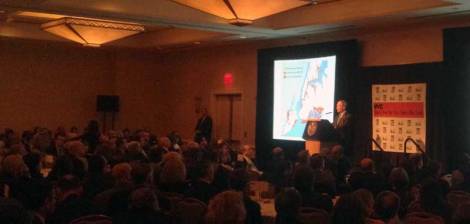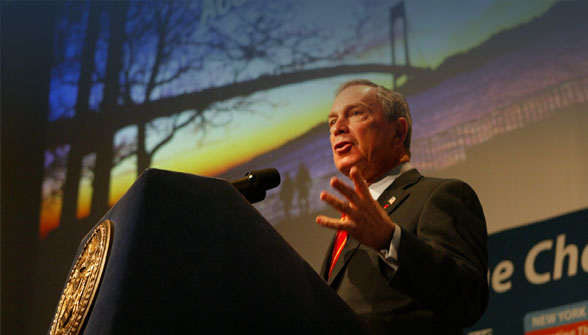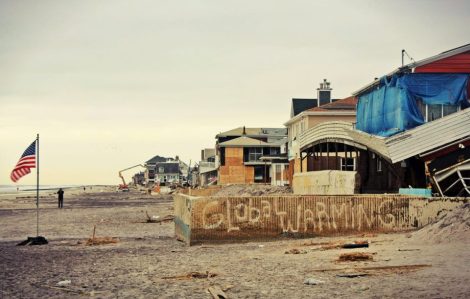Mike Bloomberg’s tenure as mayor of New York has been bookended by disaster. The primary election that vaulted him to his position was originally scheduled for Sept. 11. And with just over a year left in his term: Sandy. This morning, in a high-profile speech, Bloomberg made his case for how New York will prepare for the next climate disaster.
The mayor’s first two terms, from 2002 to 2010, were largely defined by 9/11 and how he and the city responded. The massive increase in the reach and power of the NYPD happened under Bloomberg — as did a variety of foiled terror plots of various likelihoods and origins. Bloomberg’s mantra has been safety, how even allowing NYPD to infiltrate out-of-state mosques and run a blatantly discriminatory stop-and-frisk system is worth it because crime dropped and no bombs exploded.
In 2007, just shy of halfway through his second term, Bloomberg announced PlaNYC, a push to prepare the city for a changing climate. “We’re going to seize this opportunity,” Bloomberg said at the time, “to lead the way forward and create the first environmentally sustainable 21st-century city.” The plan moved forward without much fanfare, particularly once a signature element, congestion pricing, was killed. Nonetheless, as Bloomberg noted today (and as we’ve discussed before), the city launched a $2.4 billion green water infrastructure plan, revamped zoning, and restored wetlands.
What Sandy showed was how spotty the city’s preparation actually was, five years down the road. While large portions of New York City woke up the day after the storm, yawned, and went about their business, hundreds of thousands woke up in the dark. Thousands woke up above flooded first floors. Dozens never woke up. Today, five weeks afterward, parts of the largest, richest city in America are still dark; just blocks from the arhythmically beating heart of the world of finance, massive buildings are still not ready to be reentered.

Mike Bloomberg makes his speech.
At this morning’s event in lower Manhattan, Bloomberg joined Al Gore and Michael Brune, executive director of the Sierra Club, to outline how the city would recover from Sandy and work to prevent similar damage from happening again in the future. Held at a hotel that had been flooded during the storm by the Hudson River, which lies just across the street, the event felt like a scene from the end of a disaster movie — the celebrity mayor describing how the city would rebuild, but smarter; would again plan for the future, but wiser. “Remember: There are no panaceas or magic bullets,” Bloomberg noted, in perhaps the most elegant summary of the speech. In a city as diverse and distributed as New York, the problems and points of failure are innumerable.
Bloomberg first detailed the recovery efforts. “In our city’s long history, we’ve never had a storm like Sandy,” he said. The surge at the Battery exceeded 14 feet — something that FEMA gave a less than 1 percent chance of happening. After 2011’s Hurricane Irene, the city remapped Zone A, the area most likely to flood in a big storm. Flooded areas again far exceeded Zone A — and extended far past the areas designated as a 500-year flood zone in FEMA’s most recent map of possible flooding. It is from 1983.
In the weeks since Sandy, the Department of Sanitation removed some 350,000 tons of debris and wreckage from flooded areas. The city has provided loans to nonprofits and small businesses. A sewage treatment plant in the Rockaways was brought back online in two days, Bloomberg noted, comparing it obliquely to the facility in New Jersey that’s still not working properly. The city is assisting homeowners in finding contractors to assess and repair gas and electrical systems — all on FEMA’s tab.
But the heart of Bloomberg’s presentation was on moving forward. “We live next to the ocean, and the ocean comes with risks that we just cannot eliminate,” the mayor said. He disparaged the much-discussed idea of a seawall, but suggested that other systems — dunes and levees, for example — could be effective in lessening damage. People will be allowed to rebuild by the shore, but with flood mitigation measures in place and with revamped height restrictions to prevent buildings from being flooded. Throughout the city, cell towers will need to have backup systems that last for more than eight hours. ConEdison, the largest regional power provider, will invest $250 million in upgrades to prevent the sort of widespread blackout that is still ongoing in parts of the city.
As the push begins in earnest for funding from Washington — earlier today, the president suggested he’d seek $50 billion in relief, far less than regional leaders have sought — the mayor was deliberate in thanking the federal government for its efforts. He did, however, note that it was at times slow: The city will move ahead with its own assessment of better preparing for flooding while the Army Corps of Engineers undertakes a three-to-five-year study process.
One of the more striking aspects of this morning’s event was the tonal difference between Bloomberg and the man who introduced him, Al Gore. Gore railed against government inaction. “What will it take for the national government to wake up?” he asked.
Our democracy has been hacked. It no longer functions as it is intended to, to serve the public interests. And when the large carbon polluters and their ideological allies tell the members of Congress, they do say: how high? …
This country is the only nation that can provide global leadership. And the dysfunctional governance globally is directly related to the dysfunction of the government here, in our own country.
Perhaps because of the need for votes from those members of Congress, Bloomberg demurred from similar exhortations, even saying that “you can argue about what caused the weather to change,” but it is changing.
At one point, Bloomberg almost wistfully noted the resilience of New Yorkers and the city’s long tradition of recovery from disaster — including 9/11. Quoting former Mayor Ed Koch, “New York City is where the future comes to audition.” The mayor regularly and proudly notes how the city passed the audition posed by 9/11. But that was unforeseen, unexpected, an improv. Climate change has been a shadow approaching on the horizon that many people, including Bloomberg, have seen coming.
“We may or may not see another storm like Sandy in our lifetimes, but I don’t think it’s fair to say that we should leave it to our children to prepare for the possibility,” Bloomberg said this morning. The mayor’s legacy may very well be not how the NYPD and the FBI set up and knocked down a few Muslim men, but how he laid the groundwork for a New York that is truly prepared for climate disaster. No doubt to Bloomberg’s consternation, he only has one year left to do so.





